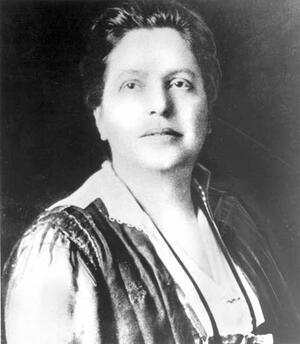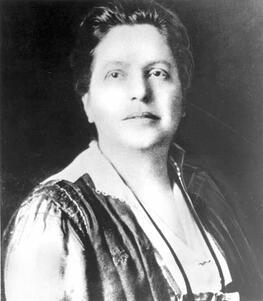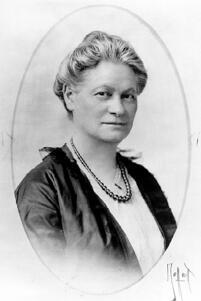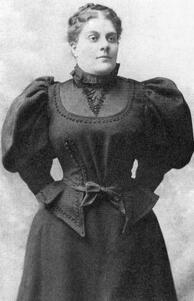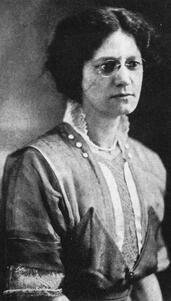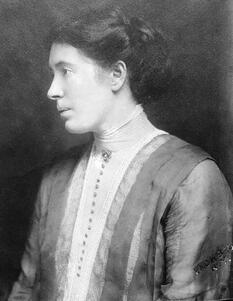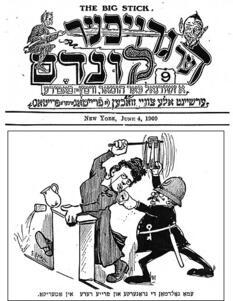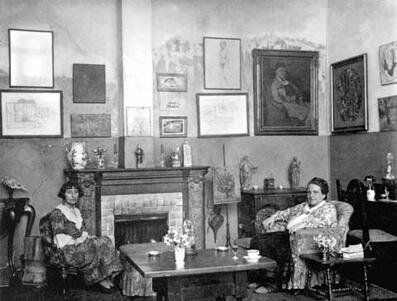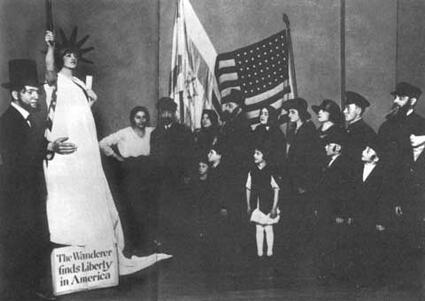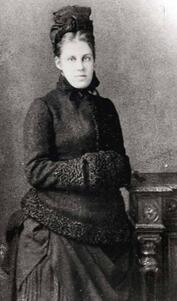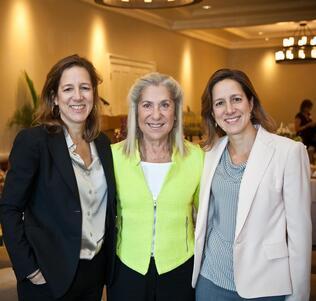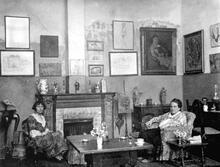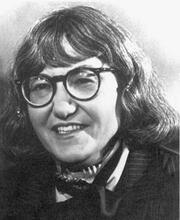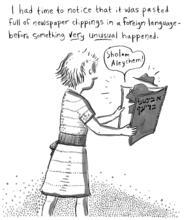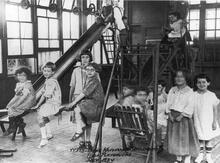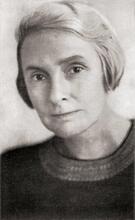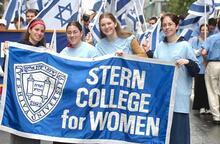Autobiography in the United States
Scholars only know of a handful of autobiographies by Jewish women before the twentieth century, thus making the plethora of American Jewish women’s autobiographical writing particularly outstanding. As the status and role of women in American and Jewish life began to change throughout the twentieth century, more and more American Jewish women turned to autobiographical writing as a means of documenting these changes and addressing questions of American, Jewish, and female identity. What has emerged as a result of these decades of Jewish women’s autobiography is a kind of Jewish American woman’s autobiographical tradition, in which writers refer to and challenge the versions of Jewish, American, and female identity and life presented by their predecessors.
“I was born, I have lived, and I have been made over. Is it not time to write my life’s story?” So begins The Promised Land, by Mary Antin, one of the best-known autobiographies penned by an American Jewish woman. Since the publication of Antin’s classic work in 1912, there has been a virtual outpouring of autobiographical writing by American Jewish women. American Jewish women have contributed copiously to such categories of autobiography as accounts of the immigrant experience, of feminist and/or activist involvement, of the changing role of women in Jewish and American life, as well as literary and political autobiographies, Holocaust survival narratives, and coming-of-age memoirs.
The Rise of Jewish-American Women’s Autobiographical Writing
This plethora of female Jewish autobiographical writing is especially striking given that scholars know of only a handful of autobiographies by Jewish women before the twentieth century. Several sociohistorical factors contributed to the rise of American Jewish woman’s autobiographical writing during this period. At the turn of the century, middle-class American Jewish women, like their gentile counterparts, began to turn away from the tenets of Victorian “True Womanhood” and became increasingly involved in the women’s movement—in the campaign for female suffrage, birth control, and greater educational/vocational opportunities for women. As the status and role of women in American and Jewish life began to change, more and more American Jewish women turned to autobiographical writing as a means of documenting these changes and addressing questions of American, Jewish, and female identity. Harriet Lane Levy’s 920 O’Farrell Street (1947) and Sophie Ruskay’s Horsecars and Cobblestones (1949) offer personal views of Jewish girlhood just before the role of women began to be questioned. Autobiographical works by women such as Lillian D. Wald, founder of the Henry Street Settlement (The House on Henry Street, 1915, and Windows on Henry Street, 1934); Annie Nathan Meyer, founder of Barnard College (Barnard Beginnings, 1935, and It’s Been Fun, 1951); and her sister Maud Nathan, an activist for female suffrage and social welfare (Once Upon a Time and Today, 1933) tell stories of Jewish women’s contributions to various social and feminist causes, while memoirs by National Council of Jewish Women founder Hannah Solomon (Fabric of My Life, 1946) and immigrant educator and activist Rebekah Kohut (My Portion, 1925, and More Yesterdays, 1950) offer specific insights into the development of Jewish women’s organizations.
Immigrant Jewish Women Autobiographies and the American Dream
Eastern European Jewish immigration to America in the late nineteenth and early twentieth centuries provided an even greater impetus for autobiographical writing. In a 1927 introduction to Rebekah Kohut’s first book, My Portion, Henrietta Szold (an important activist and scholar in her own right) offers an explanation of this phenomenon. Szold contends that for Jews in general, and Jewish women in particular, to begin writing autobiography, they needed first to discover the self—to free themselves from the staunchly communal perspective that had been forced upon them by centuries of collective persecution. The emancipation of the Jews in Europe in the eighteenth and nineteenth centuries abetted this process of self-discovery. Under these new historical circumstances, Jews began to assimilate into European culture and thus to feel the need to write the story of their enlightened, transformed lives. The waves of immigration to America provided even more dramatic stories of self-transformation. Crossing over to the promised land of opportunity and upward mobility, Jewish men and women began to make themselves over, to discover or invent new selves. Many Jewish men and women turned to writing autobiography as a means of chronicling this metamorphosis and coming to some understanding of the ambiguous relationship between the Old World and the New, between Jewishness and Americanness. For Jewish women immigrants, the new opportunities for education and advancement available to them in America only heightened these questions of identity and relationship with the past. If life in the European (Yiddish) Small-town Jewish community in Eastern Europe.shtetl did not always afford Jewish women the narratives of transformation and the consciousness of self that are the preconditions for autobiographical writing, the journey across the sea from poverty to opportunity, from female shtetl ignorance to American learnedness and literariness, certainly did.
Some of these immigrant women autobiographers chose to tell of this journey in their mother tongue of Yiddish. In Mayn Lebens-Veg [My life path] (1948), Yiddish writer/activist Rokhl Kirsch Holtman tells of her immigrant journey from Russia to New York, her many literary and left-wing political activities, as well as her various travels throughout the world. Baym Fentster fun a Lebn [At the window of life] (1966) by poet Aliza Greenblatt offers a Yiddish prose account of life in both the Old World and the New, interspersed with poems relating to various stages of her life. Likewise, fiction writer Fannie Edelman’s memoir Der Shpigl fun Lebn (1948), translated into English and published as The Mirror of Life in 1961, recalls her childhood in Galicia as well as her new life in New York, where she met her “industrious hardworking” husband, and realized an ambition “that did not enter [her] mind while [she] was in the old world: that of being a writer.”
English as Autobiographical Narrative of Transformation
For others, the English language was an integral part of the autobiographical narrative of transformation. Mary Antin’s The Promised Land is an unabashed celebration of the English language and of America. It is based, in part, on From Plotzk to Boston (1899), Antin’s earlier account of her voyage from Russia to America, written as a series of Yiddish letters to her uncle when she was thirteen years old and then translated into English when she was eighteen. The Promised Land tells of Antin’s life in the Russian Pale of Settlement, her immigration to America, and her cultural/spiritual rebirth as an American citizen and writer. Like many other immigrant autobiographers, Antin represents her immigrant experience in lofty, quasi-biblical terms as an exodus from the bondage of Eastern Europe to the promised land of America. George Washington becomes her Moses; the public library, her temple. The miraculous educational and vocational opportunities that are scattered in Antin’s path are compared to manna in the desert. America becomes not merely a country, but a grand spiritual legacy that she—unlike her older brother and sister who are sent to work to support the family—is privileged to inherit. Indeed, while the Antin family often stoops beneath the immigrant burdens of poverty, Mary Antin herself is singled out for success, “passed on from hand to hand by ready teachers” and benefactors and welcomed into genteel American society.
My Mother and I (1917) by Elizabeth Stern tells a similarly ebullient story of Americanization, although Stern is somewhat more candid about the price an immigrant woman pays to become an American. Like Antin, Stern proves to be a gifted student and writer. However, in contrast to Mary Antin, who develops her American identity very much apart from her family, Elizabeth Stern develops her authorial and autobiographical “self” alongside her mother, her greatest ally and supporter. Indeed, Stern’s writing career begins in her mother’s kitchen, where she sits composing letters for her illiterate immigrant neighbors to their relatives in the Old Country, her mother always at her side helping her with the more difficult compositions.
Eventually, however, Elizabeth’s talents and aspirations draw her away from her mother’s kitchen. On her first day of high school, when her fellow students gasp at the sight of the lunch her mother prepared for her, a newspaper-packed mélange of gefilte fish and potatoes, Elizabeth resolves to throw away all the lunches her mother gives her in the trash can outside the school. Slowly but surely, Elizabeth begins to discard not only the physical but also the emotional, products of her mother’s kitchen, replacing her mother’s friendship with her American-born high school and college friends. From then on, Elizabeth, who moves to New York to study social work and marries an American-born man, becomes allied with a model of feminine identity completely different from that of her mother’s. “To my eyes,” Stern writes, “my mother’s life appeared all at once as something to be pitied–to be questioned.”
Through writing about her own life, Stern attempts to make peace with the loss of her past. In a subsequent fictional autobiography entitled I Am a Woman and a Jew (1926), which she published under the pseudonym Leah Morton, Stern revisits this past and changes the end of the story. This pseudonym, composed of a biblical first name and a gentile/American family name, highlights Stern’s desire to reinvent her original autobiographical account—to pit her newfound American identity against her Jewish past and come to some sort of resolution. In this revision of her life story, Leah, like Elizabeth, pursues an education against her father’s wishes, drifts away from her beloved mother, and marries an American-born man—this time, a gentile. Ironically, it is the flagrant act of marrying out of the faith that leads Leah to reembrace her Jewish identity. If My Mother and I is the story of Elizabeth’s estrangement from her past, I Am a Woman and a Jew represents an attempt on the part of a onetime assimilationist to reassess the importance of her past and make sense of her identity as “a woman and a Jew.” Leah’s search for the meaning of her Jewishness is accompanied by her struggle to balance her literary, personal, and professional aspirations, her career objectives with her responsibilities as a mother. At first, writing is Leah/Elizabeth’s means of escaping the Jewish ghetto and taking possession of the American dream. Later it becomes a means of reaffirming the various aspects of her identity, of reconnecting not only with America, but also with the spiritual nourishment of her beloved mother, as well as the scholarship of her rabbinical father, for “writing can be preaching too,” Stern/Morton writes, “as fervent and holy as that from the pulpit.”
The act of writing takes on a hallowed quality in other autobiographies by immigrant Jewish women. For Elizabeth Hasanovitz, author of One of Them: Chapters from a Passionate Autobiography (1917), writing offers an opportunity both to embrace the promise of America and to reinforce her solidarity with her fellow immigrant workers. When Hasanovitz is paid by an industrial efficiency expert to write her book—an account of her experiences as an immigrant Jewish sweatshop worker and labor activist—she feels at long last that she has found America. “And so I have emerged,” she writes, “and risen 1800 feet above the sea level; amidst high mountains trimmed with red, green and yellow trees—bright life Oriental rugs.” Hasanovitz quickly reproaches herself, however, for lifting herself above the lot of the common worker, thus reaffirming her commitment to the broader workers’ struggle for “that wonderful dawn!”
In I Came a Stranger: The Story of a Hull-House Girl, Hilda Polachek offers a similarly enthusiastic account of the relationship between writing and the promise of America. In Polachek’s case, a successful composition written for an English class at Jane Addams’s Hull House earns her a partial scholarship to attend the University of Chicago. Polachek never finishes her degree. Eventually she marries and moves to Milwaukee, where she dedicates herself to her husband, children, and volunteer activities. But when her husband dies and she is beset by the financial problems endemic to the Depression, writing again becomes her lifeline, as she finds a job on the Illinois Writer’s Project, writing articles on various social welfare subjects connected with her Hull House experiences.
Likewise, I Belong to the Working Class, the autobiography of writer/activist Rose Pastor Stokes, offers an example of the way the act of writing helps the author claim and clarify her American immigrant working-class identity. Stokes’s unfinished autobiography tells of her escape from the grind of a Cleveland cigar factory to a job as a reporter for the woman’s page of the New York-based Der Yidishes Tageblat. In her capacity as a reporter, she is sent to interview millionaire philanthropist James Graham Phelps Stokes, whom she eventually marries in storybook fashion. The Cinderella plot unravels, however, when aristocratic James begins to disagree with Rose’s brand of radical socialism and Rose becomes increasingly uncomfortable among the riches of the Stokes family. In one scene in the autobiography, Rose tells of her search through the thousands of books in the Stokes family library for a book “which tells of how the poor can do away with their poverty” only to find one volume after another “about great men.” Stokes’s autobiography, in which she affirms her allegiance with “the poor, the sick, the needy, and the suffering,” is her attempt, albeit quixotic, to write the sort of socially conscious book that she had been looking for.
The autobiography and autobiographical fiction of Anzia Yezierska (who used Rose Pastor Stokes’s life story as the subject of her first novel, Salome of the Tenements, 1923) perhaps best illustrates the relationship between the act of writing and the immigrant quest for the American dream. Unlike Antin and Stern, who spearheaded their literary careers with the writing of an immigrant autobiography, Yezierska was first and foremost a fiction writer, so much so that in reading her autobiography Red Ribbon on a White Horse (1950) it is somewhat difficult to tease out fact from fiction. In much of her writing, Yezierska tells and retells the story of her own struggle to become an American writer. Yezierska’s hunger for self-expression remains unsatisfied even in her autobiography, in which she tells of her emergence from East Side poverty to Hollywood, where she was given two lucrative contracts for film adaptations of her first two books. As her autobiography shows, Yezierska continually doubts her success, ruminates over her female immigrant identity and her relationship with the patriarchal religion of her rabbinic father, and struggles to find a proper place for her writing and her “self” in American culture. Too “green” for the New World, and yet too American for the Old, Yezierska occasionally finds her American home in her writing, although more often than not, the world of writing proves to be a place of exile as well.
Living My Life (1931), the autobiography of anarchist Emma Goldman, provides an even more extreme example of female exile. An immigrant from Lithuania, Goldman tells of her anarchist convictions and her disillusionment with America. Staunchly opposed to all traditional social and sexual values, she leaves her husband, travels around the country preaching her anarchist gospel, and participates in an assassination plot and other illegal activities that result in her imprisonment and eventually her deportation to Soviet Russia. Goldman arrives in Russia ready to embrace the revolution and to serve her “beloved matushka,” only to be disillusioned once again by Lenin’s regime. Exiled both from America and from her Russian motherland, Goldman wanders from place to place in search of an ideal anarchist way of life, ending her life in St. Tropez, where she writes her autobiography.
In keeping with the wandering and subversive nature of her life, Goldman’s autobiography takes readers into various forbidden spaces and places. Unlike Antin and Yezierska, who omit all discussion in their autobiographies of their relationships with their husbands, their children, and their attitudes toward sexuality (Antin refers obliquely to her husband as “one of her learned friends,” and Yezierska makes veiled references to her affair with philosopher John Dewey), Goldman speaks freely about almost every stage and issue of her sexual history: her sexual awakening, her experience of being date-raped as a young woman, her various lovers, her inability to conceive children, her attitudes about marriage, birth control, and so on. As Betty Ann Bergland notes, what is so remarkable about this long, often rambling text is that in addition to entering into these forbidden private spaces, Goldman also claims a place for women in such public spaces as the lecture and union halls and the political arena.
Of course, not all immigrant autobiographies present such a radical vision of American Jewish female life. Goldie Stone’s My Caravan of Years: An Autobiography, Etta Byer’s Transplanted People, Hilda Polachek’s I Came a Stranger, Fannie Edelman’s Der Shpigl fun Lebn, and Aliza Greenblatt’s Baym Fentster fun a Lebn all concern themselves with issues of professional and personal aspiration and yet endorse the idea of marriage and the traditional family.
Gender Roles and Heterosexual Stereotypes
Institution: Yale Collection of American Literature, Beinecke Rare Book and Manuscript Library
What is perhaps even more fascinating is the extent to which seemingly revolutionary or iconoclastic narratives, when examined closely, reaffirm traditional stereotypes and conventional gender roles. The Autobiography of Alice B. Toklas by Gertrude Stein, an account of Stein’s expatriate life in Paris, written as if from the mouth of her lesbian domestic partner, Alice B. Toklas, is a case in point. On the one hand, the frequent references in the Autobiography to Stein’s literary genius and her importance as the central figure in Parisian modernism represent a kind of breakthrough: Here is a (Jewish lesbian) woman unabashedly claiming her position as a great modern artist. Of course, Alice B. Toklas’s position in the narrative complicates this reading. Throughout the Autobiography, Toklas plays the role of wife/female domestic catering to Stein’s masculine genius. At the end of the Autobiography, Stein mocks Toklas’s domesticity outright, suggesting that Toklas title her autobiography “Wives of Geniuses I Have Sat With.” Toklas is so much the stereotypical “wife of genius” that she cannot even muster the intelligence to write her own life story. Stein, the real genius, must do it for her. In the end, the Autobiography reinforces the same heterosexual stereotypes that it seemed at first to oppose.
A Peculiar Treasure (1940), the autobiography of writer Edna Ferber, poses a similar problem. On the one hand, Ferber provides an inspiring, iconoclastic account of Jewish female professional success. Despite the advice of an early acquaintance that she “try to do something decent, like teaching school,” Ferber becomes a reporter in Milwaukee, working for three years “like a man,” and then becomes a best-selling author, beginning with her stories of Emma McChesney, an American businesswoman. On the other hand, by describing her professional life as man’s work, Ferber indirectly reinforces the notion that work is a male domain, and that a working woman must shrug off something of her feminine identity in order to gain admittance into this realm. Ferber herself never married or had children. Her autobiography offers little mention of a romantic or personal life. Although she insists she knows “no woman with whom she’d want to exchange places,” it is clear that she pays a price for her “masculine” career.
My Life (1975), the autobiography of one-time Israeli prime minister Golda Meir, who emigrated from America to Palestine in 1921, presents yet another account of the pitfalls of living and working “like a man.” Meir’s political involvements repeatedly take her away from her husband and children. Over and over again in the memoir, she reproaches herself for failing to be a good wife and mother while she pursued a career in public service. Ironically, however, when reflecting on her political career, Meir insists that her “being a woman never hindered her in any way at all,” that it never caused her “unease” or made her “think that men are better off than women.” Her denial of the relevance of gender in politics belies the extent to which she had to efface her femininity to get where she did in Israeli political life.
Jewish-American Women’s Autobiographical Tradition and Evolution
Works like Edna Ferber’s A Peculiar Treasure and Golda Meir’s My Life are significant today precisely because of the criticism they provoke. What has emerged as a result of these eight or nine decades of Jewish women’s autobiography is a kind of Jewish American woman’s autobiographical tradition, in which writers refer to and/or challenge the version of Jewish/American/female identity and life presented by their predecessors. In the same way that Rebekah Kohut invokes such biblical “foremothers” as Sarah and Deborah, and writer Annie Nathan Meyer invokes the inspiration of her poet relative Emma Lazarus, contemporary autobiographers celebrate and/or debate the achievements of their predecessor autobiographers. In Generation Without Memory: A Journey in Christian America (1981), a personal meditation on the problem of Jewish identity in America, novelist Anne Roiphe contrasts her assimilated American perspective with the pious outlook of Glückel of Hameln, a businesswoman and mother who wrote her memoirs in Yiddish in the late seventeenth and early eighteenth centuries. In Deborah, Golda and Me (1991), feminist activist and Ms. magazine founder Letty Cottin Pogrebin refers to Golda Meir as a “fantasy mother,” and yet calls her to task for failing to take possession of her entire identity and for “opting out” of her womanhood. Likewise, in her exquisitely thoughtful and nuanced immigrant autobiography, Lost in Translation: A Life in a New Language (1989), Eva Hoffman lovingly recalls her predecessor Mary Antin, and yet criticizes her for being too optimistic in her depiction of the immigrant experience—for foregrounding “certain parts of her own experience, and [throwing] whole chunks of it into the barely visible background.”
Where they do not explicitly refer to the work of their predecessors, contemporary Jewish women autobiographers often—consciously or unconsciously—revisit the primary themes of earlier women’s autobiographies. My Mother and I by Elizabeth Stern, Of Woman Born: Motherhood as Experience and Institution (1976) by Adrienne Rich, In My Mother’s House (1983) by Kim Chernin, and Fierce Attachments (1987) by Vivian Gornick all deal with complicated, sometimes “love-hate” Jewish mother-daughter relationships. Gornick, Rich, and Kate Simon, in her companion memoirs, Bronx Primitive: Portraits in Childhood (1982) and A Wider World: Portraits in Adolescence (1986), all touch upon many of the same sexual-political issues treated in Emma Goldman’s Living My Life. Shulamit Soleveitchik Meiselman’s The Soleveitchik Heritage: A Daughter’s Memoir provides a history of the famous Soleveitchik rabbinic dynasty. In it, Meiselman considers some of the same issues concerning a modern woman’s role in the rabbinic world that are treated in Rebekah Kohut’s My Portion and in a self-published memoir by Esther Bengis entitled I Am a Rabbi’s Wife (1935). Isabella Leitner’s Holocaust-immigration memoir Saving the Fragments tells the story of her arrival in America following her liberation from Auschwitz, in language that roughly approximates the celebratory tones of Antin’s and Stern’s immigrant autobiographies. Arriving in the United States on V-E Day, Leitner writes, “We cannot believe that we are in the center of modern man’s most momentous day. To arrive in America on the very day the war ends is too much for us to demystify.” Of course, Leitner’s use of the word “demystify” hints at the quasi-illusory nature of the American dream, thus recasting Antin’s picture of America. Finally, Roya Hakakian’s eloquent Journey From the Land of No (2004) expands the canon of American Jewish women’s autobiography by telling the evocative story of Hakakian’s girlhood in Tehran, the horror of post-revolutionary Iran under Khomeini, and her immigration with the rest of her family to the United States in 1984. The Jewish female immigrant experience, the changing role of women in American and Jewish life, issues of female sexuality and gender relations, and the act of writing as a kind of liberation or religious redemption are issues that continue to be treated by contemporary American Jewish women, part of an unfolding tradition of American Jewish women’s autobiography.
Selected Autobiographies by American-Jewish Women
Adlerblum, Nima. Memoirs of Childhood: An Approach to Jewish Philosophy (1999).
Abzug, Bella. Bella! (1972).
Antin, Mary. From Plotzk to Boston (1899) and The Promised Land (1912).
Bacall, Lauren. By Myself (1979).
Bengis, Esther. I Am a Rabbi’s Wife (1935).
Berg, Gertrude, with Cherney Berg. Molly and Me (1961).
Calisher, Hortense. Herself (1972).
Chernin, Kim. In My Mother’s House (1983).
Chicago, Judy. Beyond the Flower: The Autobiography of a Feminist Artist (1996).
Cohen, Rose. Out of the Shadow (1918).
Comden, Betty. Off Stage (1995).
Davidson, Jo. Between Sittings: An Informal Autobiography (1951).
Dawidowicz, Lucy S. From That Place and Time: A Memoir (1989).
Edelman, Fannie. The Mirror of Life (1961), and Der Shpigl fun Lebn (1948).
Feldman, Rivke. A Mames Bukh (1950. Translated as Mother’s Book, 1950).
Ferber, Edna. A Kind of Magic (1963), and A Peculiar Treasure (1949).
Franken, Rose. When All is Said and Done (1962).
Freund-Rosenthal, Miriam. In My Lifetime: Family, Community, Zion (1989).
Goldman, Emma. Living My Life (1931).
Gornick, Vivian. Fierce Attachments (1987).
Greenblat, Eliza. Baym Fenster fun a Lebn (1966).
Grossinger, Jennie, as told to Harold Taub. Waldorf in the Catskills (1950).
Guggenheim, [Peggy] Marguerite. The Informal Memoirs of Peggy Guggenheim (1946).
Hakakian, Roya. Journey From the Land of No: A Girlhood Caught in Revolutionary Iran (2004).
Hamburger, Estelle. It’s a Woman’s Business (1939).
Hart, Sara L. The Pleasure Is Mine: An Autobiography (1947).
Hartman, May. I Gave My Heart (1960).
Hasonovitz, Elizabeth. One of Them: Chapters from a Passionate Autobiography (1917).
Heilbrun, Carolyn G. Writing a Woman’s Life (1988).
Hilf, Mary Asia, as told to Barbara Bourns. No Time for Tears (1964).
Hoffman, Eva. Lost in Translation: A Life in a New Language (1989).
Holtman, Rokhl. Mayn Lebens-Veg (1948).
Hurst, Fannie. Anatomy of Me: A Wanderer in Search of Herself (1958).
Jastrow, Marie. Looking Back: The American Dream Through Immigrant Eyes (1986), and A Time to Remember (1979).
Kern, Janet. Yesterday’s Child (1962).
Kent, Allegra. Once a Dancer ... (1997).
Kohut, Rebekah Bettelheim. More Yesterdays: An Autobiography (1950), and My Portion (1927).
Kositza, Rachel Anna. Zikhroynes fun a Byalistoker Froy (1964).
Krantz, Judith. Sex and Shopping: The Confessions of a Nice Jewish Girl (2000).
Kunin, Madeleine. Living a Political Life (1994).
Lang, Lucy Robbins. Tomorrow Is Beautiful (1948).
Lauder, Estee. Estee: A Success Story (1985).
Leader, Pauline. And No Birds Sing (1931).
Leitner, Isabella. Saving the Fragments; From Auschwitz to New York (1985).
Lerner, Gerda. Fireweed: A Political Autobiography (2002).
Levy, Harriet Lane. 920 O’Farrell Street (1947).
Lindheim, Irma. Parallel Quest (1962).
Mednick, Martha. “Autobiography.” In Models of Achievement: Reflections of Eminent Women in Psychology. Vol. 2, edited by Agnes N. O’Connell and Nancy F. Russo (1988): 245–259.
Meir, Golda. My Life (1975).
Meiselman, Shulamit Soleveitchik. The Soleveitchik Heritage: A Daughter’s Memoir (1995).
Memoirs of Glückel of Hameln. Translated with notes by Marvin Lowenthal (1932).
Meyer, Annie Nathan. Barnard Beginnings (1935), and It’s Been Fun (1951).
Nathan, Maud. Once Upon a Time and Today (1933).
Piercy, Marge. Sleeping with Cats (2001).
Rich, Adrienne. Of Woman Born: Motherhood as Experience and Institution (1976).
Rivers, Joan. Enter Talking (1986) and Still Talking (1991).
Roiphe, Anne. Generation Without Memory (1981).
Roseanne. Roseanne: My Life as a Woman (1989).
Rubinstein, Helena. My Life for Beauty (1966).
Ruskay, Sophie. Horsecars and Cobblestones (1949).
Sills, Beverly. Bubbles: A Self-Portrait (1976), and Beverly: An Autobiography, with Lawrence Linderman (1987).
Simon, Kate. Bronx Primitive: Portraits in Childhood (1982), and A Wider World: Portraits in Adolescence (1986).
Solomon, Hannah Greenebaum. Fabric of My Life (1946).
Stein, Gertrude. The Autobiography of Alice B. Toklas (1933).
Stokes, Rose Pastor. I Belong to the Working Class. Edited by Herbert Shapiro and David L. Sterling (1992).
Stone, Goldie. My Caravan of Years: An Autobiography (1945).
Talbot, Rose. No Greater Challenge (1955).
Tucker, Sophie. Some of These Days (1945).
Wald, Lillian. The House on Henry Street (1915), and Windows on Henry Street (1934).
Wengeroff, Pauline. Memoiren Einer Grossmutter: Bilder aus der Kulturgeschichte der Juden Russlands im 19. Jahrhundert (1913-1919).
Westheimer, Ruth. All in a Lifetime (1987), and Musically Speaking: A Life through Song (2003).
Winters, Shelley. Shelley: Also Known as Shirley (1980), and Shelley II: The Middle of My Century (1989).
Yezierska, Anzia. Red Ribbon on a White Horse (1950).
Zunser, Miriam Shomer. Yesterday (1978).
Selected Holocaust Memoirs by American-Jewish Women
Blaikie, Evi. Magda’s Daughter: A Hidden Child’s Journey Home (2003).
Klein, Gerda. All But My Life (1957).
Leitner, Isabella. Saving the Fragments: From Auschwitz to New York (1985).
Bergland, Betty Ann. “Reconstructing the Self in America: Patterns in Immigrant Women’s Autobiographies.” Doctoral diss., University of Minnesota, 1990.
Beyer, Etta. Transplanted People (1955).
Demiturk, Emine Lale. “The Female Identity in Cross-Cultural Perspective: Immigrant Autobiographies.” Doctoral diss., University of Iowa, 1986.
Kazin, Alfred. “The Self as History: Reflections on Autobiography.” In The American Autobiography: A Collection of Critical Essays, edited by Albert Stone (1981).
Lifschutz, E. Bibliography of American and Canadian Jewish Memoirs and Autobiographies (1970).
Marcus, Jacob Rader. The American Jewish Woman: A Documentary History (1981).
Olney, James. Autobiography: Essays Theoretical and Critical (1980).
Pratt, Norma Fain. “Culture and Radical Politics: Yiddish Women Writers in America,” in American Jewish History (September 1980. Reprinted in Women of the Word: Jewish Women and Jewish Writing, edited by Judith Baskin).
Rubin, Steven J. “American Jewish Autobiography 1912 to the Present.” In Handbook of American Jewish Literature, edited by Lewis Fried (1988), and Writing Our Lives: Autobiographies of American Jews, 1890–1990 (1991).
Smith, Sidonie. A Poetics of Women’s Autobiography (1987).
Spacks, Patricia. Imagining a Self: Autobiography and Novel in Eighteenth-Century England (1976).
Zierler, Wendy. And Rachel Stole the Idols (2004).
Zierler, Wendy. “Border Crossings: The Emergence of Jewish Women’s Writing and the Immigrant Experience.” Doctoral diss., Princeton University, 1995.

